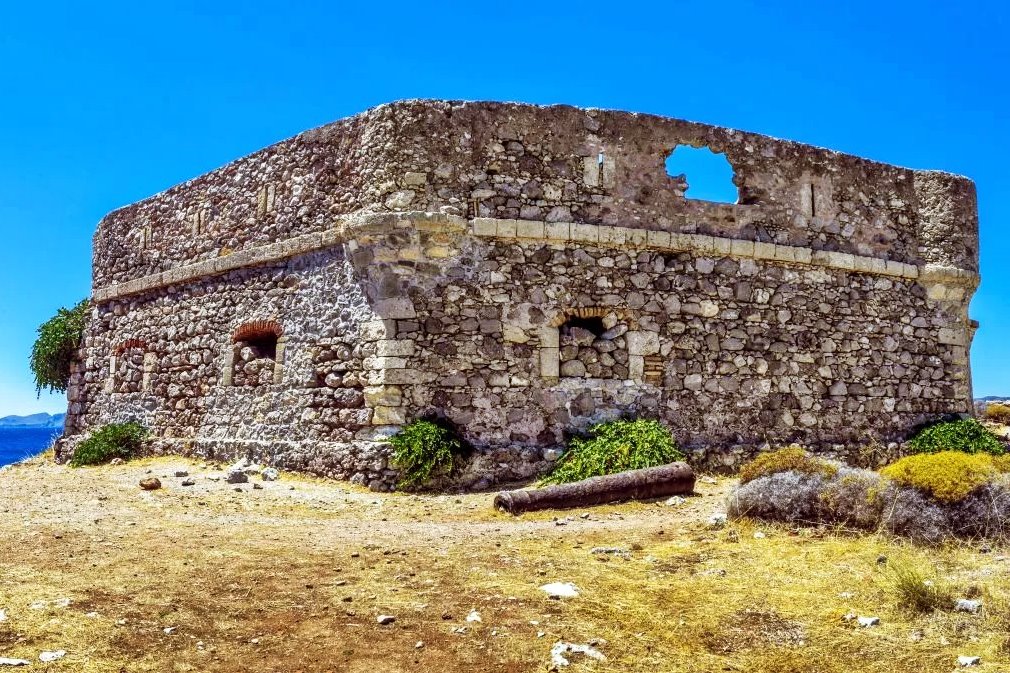Avlemonas, Cythera, Piraeus & Islands,Attica
Castle of Avlemon
| Location: |
| Avlemonas, Kythira |
| Region > Prefecture: |  |
| Attica Piraeus & Islands | |
| Municipality > Town: | |
| City of Cythera • Avlemonas | |
| Altitude: | |
| Zero Altitude |
| Time of Construction | Origin | |
| 1725 | VENETIAN |
|
| Castle Type | Condition | |
| Coastal Fortress |
Average
|
Avlemonas is a picturesque village in Kythira. At the entrance of the fishing port, there is a relatively small castle.
The castle was built by the Venetians in 1725. Its obvious purpose was to guard the port.
History
According to the archives of Venice (Archivio di Stato di Venezia) the history of the castle is as follows: In 1724 the order was given to the Provveditore Generale da Mar and governor of the Ionian Islands Francesco Correr to take action against the Maltese pirates who raided the Venetian possessions and often used the unfortified port of Avlemona as a base. Correr, in collaboration with maresciallo Johann Mathias Schulenburg, proposed to strengthen the defense of Avlemon by building a small fort that would control the entrance to the bay.
The Senate of Venice gave its approval and the work was assigned to Lieutenant Colonel engineer Moser. The budget was 2,000 rials (finally 1,122 rials and some change were spent).
The work was soon completed, (probably) in 1725. Correr sent instructions to the provveditore of Kythira about manning the fort with 24 soldiers and how to control the entrance to the port.
The Venetians called the fortress “Castelo di San Francesco”. It is also known as the “Castle of Agios Nikolaos”, as during the Venetian period the name of Avlemonas was Agios Nikolaos. The name San Francesco was probably given in honor of Francesco Correr, who as Provveditore da Mar was also governor of the Ionian Islands in the period 1723-1727, while later he became Patriarch of Venice (1735-1741).
The Venetians had taken Kythira after the fall of Constantinople from the Latins in 1204. The first Venetian ruler of the island was, from 1207, Marco Venier. The power of the Veniers was consolidated in 1238 when Marco's successor, Bartholomew Venier, married the daughter of the Greek noble Eudaimonogiannis (originally from Monemvasia).
The island remained in the hands of the Venier house until 1279, when it was captured by knight Licario who was a Lombard warlord in the service of Byzantium.
In 1308 the Veniers returned and regained control of the island. In 1310 the emperor Andronikos II made peace with the Venetians and officially recognized their jurisdiction over the islands of the South Aegean including Kythera. The Veniers remained the rulers of the island, but from 1325 there was also a military commander appointed by Venice with the title of Castellanos.
At some point from the beginning of the 16th century, the administration of Kythira was upgraded and taken over by a Provveditore, who was subordinate to the administration of Crete. After the completion of the conquest of Crete by the Ottomans, in 1669, the Prefect of Kythira was subject to Corfu.
Despite the existence of the provveditori, it seems that much of the power remained in the hands of the Veniers (some of whom were also provveditori at times). This authority seems to have been particularly oppressive for the local population as there were repeated riots against the ruling class of the island. In 1530 the Senate of Venice stripped the Veniers of all their powers and the administration of Kythera passed directly to Venice.
The island remained under Venetian control until the dissolution of the Serenissima Republic of Venice in 1797 (with a short break of Ottoman occupation in 1715-1718). It then came under the control of the French, then Russians and Turks, then again the French and finally the British.
In 1809 when the English expelled the French and occupied Kythera, they first landed in Avlemonas. In fact, then they bombarded the castle with the cannons of their ships, which suffered serious damage.
Structure, Fortification & Buildings
The castle of Avlemonas is a small fortress that occupies an area of 340 square meters. The outer perimeter of the fortification is 68 meters.
Above the castle gate is the emblem of the Serene Republic, the winged lion of Saint Mark.
The shape of the castle is octagonal. It has cannon embrasures, a central tower, warehouses, guard houses and some abandoned cannons.
It was neglected for years, but it is not in too bad a condition and lately efforts are being made to restore it.
| First entry in Kastrologos: | November 2012 | Last update of info and text: | November 2024 | Last addition of photo/video: | August 2023 |
Sources
- Ghetti, C. – Giormani, V., (2000). “La situazione di Cerigo da una prova di fortuna del 1795”, εις Α’ Διεθνές Συνέδριο Κυθηραϊκών Μελετών, 20-24 Σεπτεμβρίου 2000. (τ. Β’, 259-274)
- Λαμπρινού, Μ. (2000). «Το καστέλλι στον Αυλέμονα», εις Α’ Διεθνές Συνέδριο Κυθηραϊκών Μελετών, 20-24 Σεπτεμβρίου 2000. (τ. Α’, 259-286)
- Info and Bibliography by Christina Pinatsi
- Photos 3, 11 by Fred Kok (August 2016)
- Pictures 1, 2, 7, 8, 10, 11 and video by
G Traveller Κάστρο Αβλέμονα | Castle of Avlemon
|
|
| Access |
|---|
| Approach to the monument: |
| - |
| Entrance: |
| ? |
| Similar |
|---|
| Sigri Castle |




















